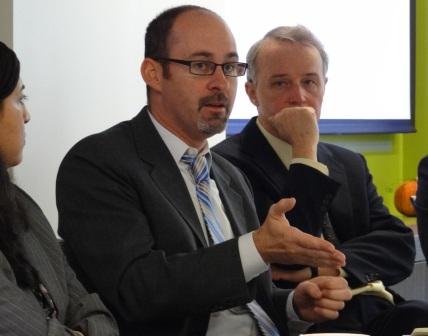On December 6, the Bretton Woods Committee organized an interactive discussion to examine how international financial institutions, corporations, governments, NGOs, and civil society are Responding to the Global Food Crisis.
Panelists Asmita Tiwari, Risk Management Specialist at the World Bank, Gawain Kripke, Director for Policy at Oxfam America, and Devry S. Boughner, Director of International Business Relations for Cargill, presented their perspectives on the causes and implications of the current crisis. Committee Executive Director Randy Rodgers served as the host for the meeting, while David Beckmann, President of Bread for the World, moderated.
Beckmann began by exploring of the importance of investing in agriculture and food security. He noted the integral role of the World Bank in dealing with the food crisis, especially as the Bank has committed $6 billion in additional funding for agriculture and nutrition in 2009 and 2010. Beckmann expressed concern over the “violent cut in agriculture appropriations” proposed by the U.S. House of Representatives in May 2011 which “would have thrown 14 million people off food-aid rations.” As the House and U.S. Senate move to conference on U.S. funding for multilateral and bilateral development assistance, he hoped that these “critical programs” will receive bipartisan support.
Each panelist was then introduced and offered the opportunity to share their perspective.
 Gawain Kripke began by trying to dispel the idea that the most recent food crisis came from a “perfect storm” of factors specific to 2008. Gawain Kripke comments on the food crisis.He emphasized that – while storms blow over – the current challenges are part of a “permanent crisis,” rooted in six structural elements. He said demand has sharply risen in recent years, because of growing populations and higher income levels. Strained food supplies due to climate change and unsustainable production practices magnify the challenge, he reported, citing the Food and Agricultural Organization’s call for a 75% increase in sustainable food production to meet anticipated demand. He also expressed concern as traditional sources of food, such as corn, are diverted to energy production. Finally, he noted the political and economic structures which impede access to food, including transportation, speculation, and the barriers between areas of production and areas of demand. Looking forward, Kripke stressed that “we need to be ... preparing funding and resources for the next [crisis] – which is bound to happen.”
Gawain Kripke began by trying to dispel the idea that the most recent food crisis came from a “perfect storm” of factors specific to 2008. Gawain Kripke comments on the food crisis.He emphasized that – while storms blow over – the current challenges are part of a “permanent crisis,” rooted in six structural elements. He said demand has sharply risen in recent years, because of growing populations and higher income levels. Strained food supplies due to climate change and unsustainable production practices magnify the challenge, he reported, citing the Food and Agricultural Organization’s call for a 75% increase in sustainable food production to meet anticipated demand. He also expressed concern as traditional sources of food, such as corn, are diverted to energy production. Finally, he noted the political and economic structures which impede access to food, including transportation, speculation, and the barriers between areas of production and areas of demand. Looking forward, Kripke stressed that “we need to be ... preparing funding and resources for the next [crisis] – which is bound to happen.”
 Asmita Tiwari concentrated on the World Bank’s work in the Horn of Africa, where nearly 12 million people in 13 counAsmita Tiwari explains the World Bank response.tries are affected by drought and famine. She discussed how a lack of rainfall has had a detrimental effect on livestock and crops and the impact of increasing energy costs on the price of food. Tiwari also noted the spillover effects of famine and drought, particularly in Somalia where an estimated 40 percent of its total population lives as internally displaced people or at refugee camps in neighboring countries. She explained that the International Development Association, Global Facility for Disaster Reduction and Recovery, and State and Peace Building Fund are making available $1.88 billion in phases: the Rapid Response phase covering the first six months and the Economic Recovery phase covering the first two years. Finally, echoing earlier comments about the need for prevention, Tiwari explained the Bank’s longer-term investment in drought-resilient agriculture, risk financing, resilience planning, and strengthening social safety nets. For more information, she recommended visiting the Bank’s website on the Drought in the Horn of Africa.
Asmita Tiwari concentrated on the World Bank’s work in the Horn of Africa, where nearly 12 million people in 13 counAsmita Tiwari explains the World Bank response.tries are affected by drought and famine. She discussed how a lack of rainfall has had a detrimental effect on livestock and crops and the impact of increasing energy costs on the price of food. Tiwari also noted the spillover effects of famine and drought, particularly in Somalia where an estimated 40 percent of its total population lives as internally displaced people or at refugee camps in neighboring countries. She explained that the International Development Association, Global Facility for Disaster Reduction and Recovery, and State and Peace Building Fund are making available $1.88 billion in phases: the Rapid Response phase covering the first six months and the Economic Recovery phase covering the first two years. Finally, echoing earlier comments about the need for prevention, Tiwari explained the Bank’s longer-term investment in drought-resilient agriculture, risk financing, resilience planning, and strengthening social safety nets. For more information, she recommended visiting the Bank’s website on the Drought in the Horn of Africa.
 Devry Boughner outlined five Ps that contribute to food insecurity: production, prices, political will, policies, and partnerships. She Devy Boughner comments on current food prices.described Cargill’s efforts to practice “food diplomacy” by working with governments, donating food, and making its sourcing more responsible. Boughner specifically highlighted Cargill’s November 2011 donation of 22 million pounds of rice to support the World Food Program (WFP)’s efforts in the Horn of Africa - enough to feed nearly 1 million people for one month. In order to contribute the 200,000 bags of rice, Cargill sourced the grain in India and managed the logistics for its 23-day voyage across the Indian Ocean. The grain arrived at the Port of Mombasa, Kenya, on November 26, where it was transferred to the WFP. She used this example to demonstrate the agility that companies can bring to crisis responses, particularly in transportation and logistics. She suggested support for international agreements to influence the pricing of food and offered ways in which governments, companies, and NGOs can work together to everyone’s benefit.
Devry Boughner outlined five Ps that contribute to food insecurity: production, prices, political will, policies, and partnerships. She Devy Boughner comments on current food prices.described Cargill’s efforts to practice “food diplomacy” by working with governments, donating food, and making its sourcing more responsible. Boughner specifically highlighted Cargill’s November 2011 donation of 22 million pounds of rice to support the World Food Program (WFP)’s efforts in the Horn of Africa - enough to feed nearly 1 million people for one month. In order to contribute the 200,000 bags of rice, Cargill sourced the grain in India and managed the logistics for its 23-day voyage across the Indian Ocean. The grain arrived at the Port of Mombasa, Kenya, on November 26, where it was transferred to the WFP. She used this example to demonstrate the agility that companies can bring to crisis responses, particularly in transportation and logistics. She suggested support for international agreements to influence the pricing of food and offered ways in which governments, companies, and NGOs can work together to everyone’s benefit.
Participants then posed a number of questions to the panel. Bill Keppler of the World Affairs Council of Washington DC asked the first question about the real and the perceived effects of corruption on food distribution and food aid. Speakers agreed that corruption has a considerable impact and outlined different steps taken by their organizations to address the challenge. Faustine Wabwire of Bread for the World posed the final question regarding the relationship between trading structures, poverty alleviation, and the food crisis. Speakers disagreed over the benefits of rejuvenating the Doha round of the World Trade Organization and whether measures should target the macro- or grassroots level in order to create lasting change.
The Bretton Woods Committee is grateful to Bread for the World for hosting this event and for their support in its successful execution.



